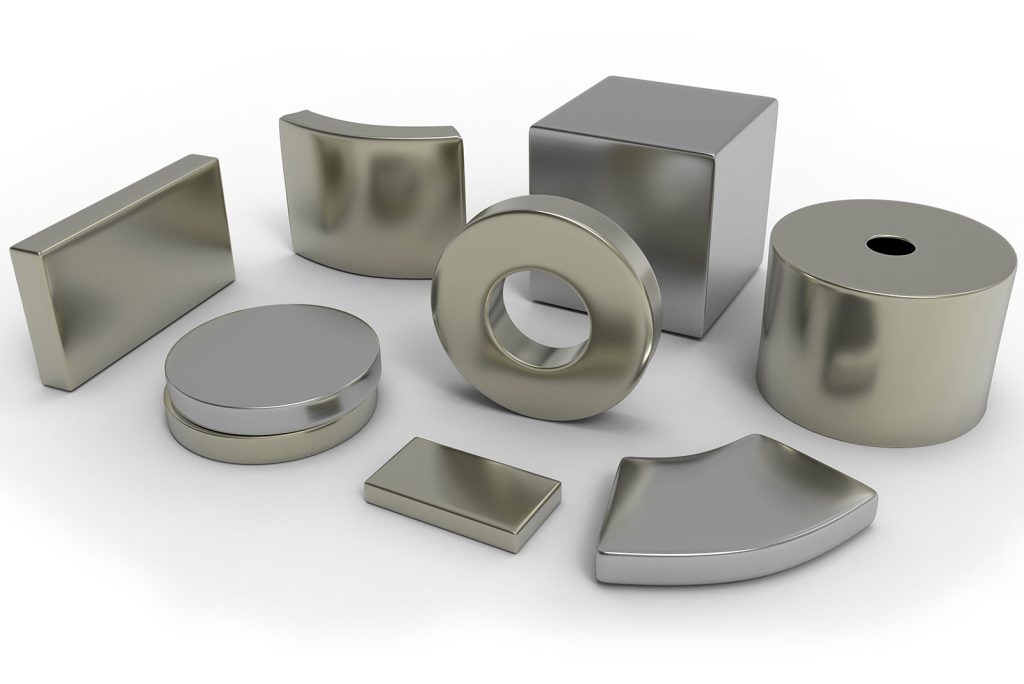Neodymium iron boron waste recycling: an unmissable treasure trove

Neodymium iron boron (NdFeB) permanent magnets are widely used in wind power generation, new energy vehicles, and electronic products due to their excellent magnetic properties, earning them the title of “King of Magnets.” However, the scrap rate in the NdFeB magnet production process is as high as 30%, and coupled with their limited lifespan, this results in a large amount of NdFeB waste.
These wastes contain up to 30% rare earth elements, far exceeding the content of primary rare earth ores, making them a highly valuable secondary resource. Efficiently recovering rare earth elements from NdFeB waste is crucial for ensuring rare earth resource security, reducing environmental pollution, and promoting sustainable development.
Characteristics and Sources of NdFeB Waste
NdFeB waste mainly originates from scraps, defective products, and retired electronic products containing magnets during the magnet manufacturing process. Its chemical composition is complex; in addition to the main rare earth elements Nd and Pr, elements such as Dy and Tb are often added to improve coercivity, and elements such as Co, Al, and Cu are added to improve overall performance. Based on rare earth element (REE) content, NdFeB waste can be classified into three categories: low rare earth (REEs < 20%), medium rare earth (20%–30%), and high rare earth (> 30%).
Currently, the recycling processes for NdFeB waste are mainly divided into pyrometallurgical, hydrometallurgical, and novel recycling technologies.
(I) Pyrometallurgical Recycling Processes
Pyrometallurgical recycling separates rare earth elements from iron through high-temperature reactions. The main methods include selective oxidation, chlorination separation, liquid alloying, and slag-metal fusion separation.
Selective oxidation is based on the fact that rare earth elements have a much higher affinity for oxygen than iron. At high temperatures, rare earth elements are selectively oxidized to form oxides, which are then separated from metallic iron. Nakamoto et al. successfully prepared mixed rare earth oxides with a purity exceeding 95% and a recovery rate exceeding 99% by precisely controlling the oxygen partial pressure.
Chlorination separation utilizes the strong affinity between rare earth elements and chlorine. Chlorinating agents such as NH4Cl, FeCl2, or MgCl2 are used to convert rare earth elements into chlorides before separation. Uda used FeCl2 as a chlorinating agent, reacting at 800℃, achieving a rare earth recovery rate of 95.9% and a product purity exceeding 99%.
The liquid alloying method utilizes the difference in affinity between rare earth elements and iron for other metals to achieve effective enrichment and separation of rare earth elements and iron. Rare earth element Nd can form various low-melting-point alloys with Ag, Mg, etc.
The slag-metal separation method is based on the characteristic that rare earth elements in NdFeB waste more readily combine with oxygen. All the metals in the NdFeB waste are converted into metal oxides. Simultaneously, under the high temperature of a slagging agent, the iron oxides are converted into metallic Fe by controlling the reducing conditions.
(II) Wet Recovery Process
Wet recovery is currently the most widely used method, mainly including the total dissolution method, hydrochloric acid preferential dissolution method, double salt precipitation method, and solvent extraction method.
(III) New Recycling Processes
New recycling technologies aim to solve the problems of high energy consumption and high pollution associated with traditional methods, including hydrogen explosion, bioleaching, and electrochemical methods.
Comparison of Different Recycling Processes and Environmental Impact
Pyrometallurgical processes have short flow rates and large processing capacities, but high energy consumption and difficulty in separating single rare earth elements; hydrometallurgical processes have high recovery rates and high product purity, but high acid consumption and high wastewater treatment costs; newer processes such as bioleaching and electrochemical methods are environmentally friendly, but are mostly in the laboratory stage and have not yet been applied on a large scale.
In terms of environmental impact, traditional recycling processes often use strong acids, strong alkalis, and high temperatures, generating large amounts of waste liquid and waste gas, increasing the environmental burden. Therefore, developing green and low-consumption recycling processes is crucial.
NdFeB waste recycling is a key way to alleviate rare earth resource shortages and reduce environmental pollution. Through technological innovation and policy guidance, the NdFeB recycling industry will develop towards greening, low cost, short processes, and high recovery rates, injecting new impetus into sustainable development.
